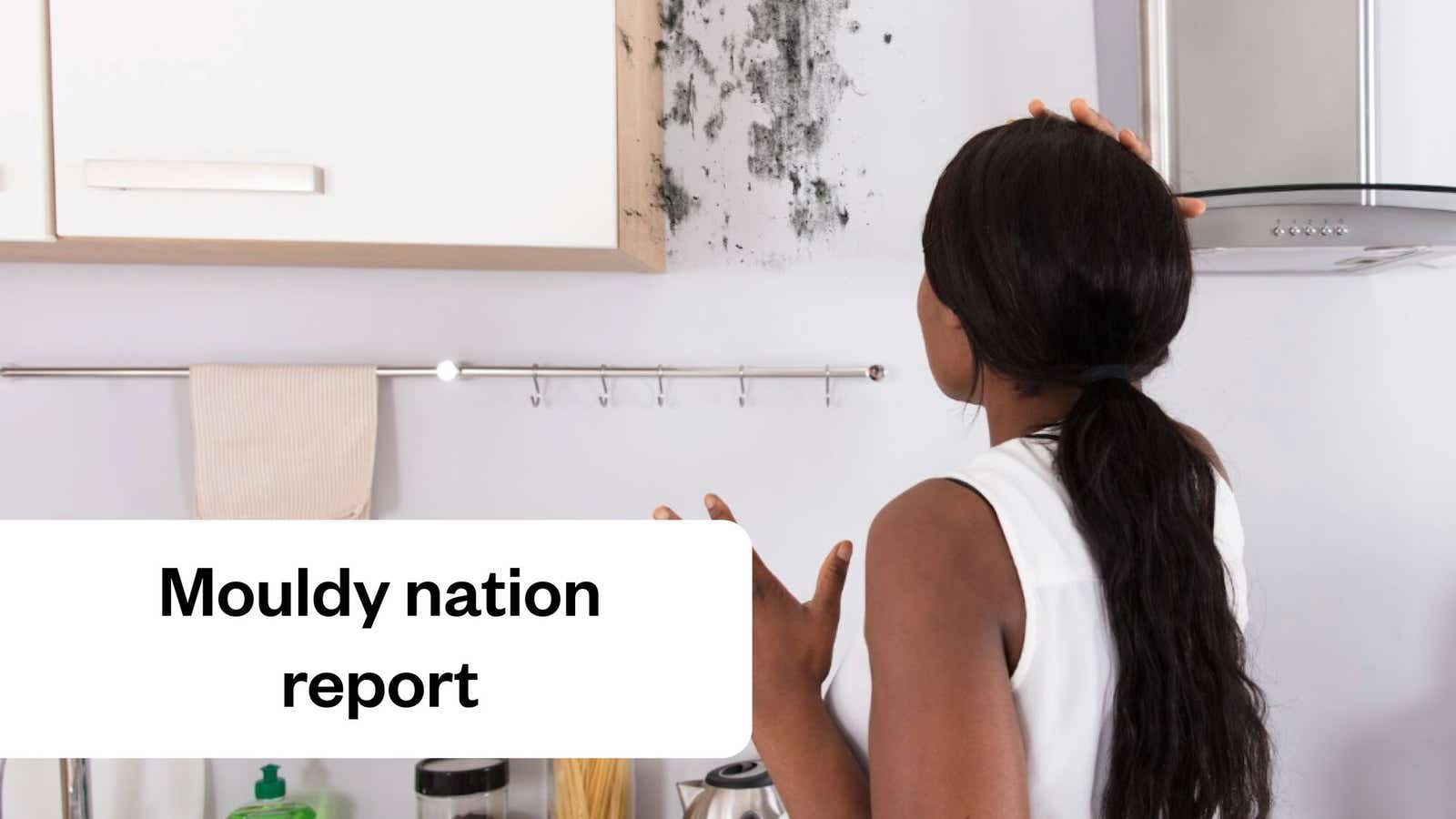The latest research by Uswitch has revealed that over 60% of people have experienced mould in their homes. This is up from 58% surveyed last year. This problem spans across all types of housing, from owned homes (43%) to privately rented properties (28%), and even local authority (16%) and housing association accommodation (12%).
Almost everyone who said they’ve experienced mould also stated that paying for adequate heating at the time was a struggle. These findings highlight the widespread impact of mould and its ties to financial strain in maintaining a warm home. For those looking to save money on their heating costs, Uswitch offers over 100 free energy-saving tips for around the home. If you’re on a standard variable tariff, you can also compare energy deals to see whether there are any suitable fixed tariffs you might want to switch to, which should also save you money.
Mould and damp complaints across England
Research by Uswitch has discovered the local authorities and housing associations with the most complaints to the Housing Ombudsman for mould and damp.
Local authority and housing association complaints
| Complaints by type of housing | Total complaints (financial years 2019/20 - 2023/24) | Estimated complaints per 10,000 units (financial years 2019/20 - 2023/24) | % change 2023-24 financial year from previous financial year |
|---|---|---|---|
| Local authority | 5,138 | 32.8 | +16.42% |
| Housing association | 10,960 | 37.5 | +17.07% |
| Total | 16,098 | 36.4 | +16.87% |
Source: FOI/Regulator of Social Housing Data
The Housing Ombudsman received more complaints about damp and mould from housing association properties than local authority properties.
Percent of the group with damp and mould found in dwellings
| Year | All dwellings | Local authority | Housing association |
|---|---|---|---|
| 2021 | 3.8 | 4.6 | 4.4 |
| 2020 | 4 | 5.4 | 4.8 |
| 2019 | 3.4 | 5.1 | 4 |
| 2018 | 3.3 | 5.1 | 4.7 |
| 2017 | 3.7 | 6.2 | 5.2 |
| 2016 | 4.2 | 6 | 3.9 |
| 2015 | 4.4 | 6.1 | 4.4 |
| 2014 | 4.3 | 5 | 4.5 |
| 2013 | 4.3 | 5.4 | 4.7 |
| 2012 | 4.3 | 6.5 | 4.4 |
| 2011 | 4.6 | 6.9 | 3.7 |
| 2010 | 6.6 | 8.9 | 6 |
| 2009 | 8.1 | 11.8 | 8.2 |
| 2008 | 7.8 | 11.9 | 8.6 |
Source: English Housing Survey
The 2022 survey did not include tenure data and may not be directly comparable to limitations caused by the COVID-19 pandemic.
According to the English Housing Survey, over the past decade, local authority housing has seen a 33% fall in damp and mould found in dwellings. At the same time, housing associations have seen a 19% rise since 2012. The proportion of all English properties with damp and mould has dropped by 17%.
Local authorities with the most complaints per 10,000 units
| Rank | Local authority area | Complaints |
|---|---|---|
| 1 | Haringey | 30.71 |
| 2 | Hammersmith and Fulham | 29.07 |
| 3 | Lambeth | 26.83 |
| 4 | Lewisham | 25.86 |
| 5 | Camden | 16.96 |
| 6 | Islington | 16.09 |
| 7 | Southwark | 16.01 |
| 8 | Adur | 15.21 |
| 9 | City of London | 14.35 |
| 10 | Lewes | 14.04 |
Source: FOI/Regulator of Social Housing Data
Of the top ten local authorities that received complaints relating to mould or damp, eight were in London. Haringey received an estimated 31 complaints per 10,000 housing units making it the most complained about local authority to the Housing Ombudsman.
Local authorities with the biggest per cent increase in the number of complaints
| Rank | Local authority | 2022/23 complaints | 2023/24 complaints | % change |
|---|---|---|---|---|
| 1 | Dover | 1 | 7 | 600% |
| 2 | Babergh | 1 | 6 | 500% |
| 3 | Oxford | 2 | 10 | 400% |
| 4 | Reading | 1 | 5 | 400% |
| 5 | Rotherham | 1 | 5 | 400% |
| 6 | West Northamptonshire | 3 | 14 | 367% |
| 7 | Ashford | 2 | 9 | 350% |
| 8 | Guildford | 1 | 4 | 300% |
| 9 | Tendring | 1 | 4 | 300% |
| 10 | North Tyneside | 2 | 7 | 250% |
(local authorities with at least 10 complaints in last 5 years)
Source: FOI
Although the proportion of English properties with damp and mould has decreased overall, some local authorities have seen large increases in the number of complaints to the Ombudsman in the last years.
West Northamptonshire only had three complaints in the financial year 2022/23 which rose by 367% to 14 complaints in 2023/24.
Top ten local authorities with the most social housing units that received no complaints
| Rank | Local authority area | No. of housing units |
|---|---|---|
| 1 | Wakefield | 36,596 |
| 2 | Buckinhamshire | 33,226 |
| 3 | Salford | 31,748 |
| 4 | Plymouth | 23,515 |
| 5 | Bexley | 15,679 |
| 6 | Hertfordshire, County of | 12,890 |
| 7 | Westmorland and Furness | 11,740 |
| 8 | Warwick | 11,132 |
| 9 | Medway | 10,345 |
| 10 | Ashfield | 9,062 |
Source: FOI
Wakefield, Buckinghamshire, and Salford all have a high number of social housing units, with over 30,000 each. Surprisingly, no complaints were made to the Housing Ombudsman for these areas about mould or damp issues.
Who is responsible for mould in a rented property?
Mould is caused by numerous factors, including everything from how the building was constructed to how furniture is arranged within the home. This often sparks disputes over responsibility. A striking 69% of respondents believe landlords are accountable for mould in a rented property, whereas a third of those surveyed said they’ve been blamed for mould in the past.
According to Shelter.org:
Landlords must fix problems that cause mould and damp, such as:
- structural problems
- faulty installation
- leaking internal pipes
- not enough ventilation
- broken boilers and heating systems
- cracked walls or rotten window frames
- leaking roofs, missing roof tiles or faulty guttering
- extractor fans they've installed.
Tenants should take reasonable steps to prevent mould and damp, such as:
- open windows regularly
- cover pans when cooking
- dry clothes outdoors or in a dryer
- close internal doors when cooking or showering
- use extractor fans in the kitchen and bathroom
- leave a gap between furniture and external walls
- wipe condensation from window sills each morning.
How to prevent mould
For those with mouldy homes, we discovered the percentage of people doing simple things around the home that may have contributed to mould growth. Try to avoid the following to prevent mould from growing in your home:
Simple actions people admit to that may contribute to mould growth
| % of people admitting to mouldy behaviour | |
|---|---|
| Dry clothes indoors | 36% |
| Rarely open windows | 22% |
| Leave kitchen or bathroom door open when cooking or showering | 21% |
| Have furniture directly against walls | 21% |
| Shower without ventilation (no extractor fan or window open) | 19% |
| Cook with uncovered pans | 17% |
| Cook without ventilation ( no extractor fan or window open) | 16% |
| Keep the shower curtain folded when wet | 12% |
| Have clutter | 11% |
| Rarely clean carpets | 9% |
| Leave spillages | 6% |
Financial help for heating the home
Having a warm home is one of the best ways to prevent mould from growing. However, as the cost of living crisis has taken hold, 68% of people have admitted that they've put their heating on less due to cost in the past two years. Over 56% of these people believe that this is a direct cause of mould becoming more of a problem in their homes.
But for the 367,119 homes without central heating in the UK, adequately heating the home consistently enough to help prevent mould can be even trickier. Our energy statistics page delves deeper into the number of households without heating.
If you’re struggling with your energy bills, there is help available. Energy suppliers are required to have plans in place to help customers who need it. There are also various government-run support schemes, such as the Warm Home Discount, Winter Fuel Payment and Cold Weather Payment.
You can also compare energy deals to see if there might be a suitable fixed tariff on offer that you could switch to.
FAQs
How to prevent mould
By making a few simple changes within the home, you can help prevent mould from growing in your home.
Try to dry clothes outdoors or in a dryer where possible.
When cooking or showering, keep the room door closed. Make use of any ventilation fans every time, or open a window.
Maintain a healthy airflow throughout the home by opening windows frequently.
Take furniture directly off walls. Having a small gap between an item of furniture and the wall can mean a healthier airflow.
Cover saucepans with a lid when cooking, and ensure the extractor fan is on, especially when removing the lid.
Try to declutter. Untouched items piled on one another can become a breeding ground for mould.
Straighten out the shower curtain when wet. This also applies to anything else that may be damp in the house.
Mop up spillages instantly, and dry the area as best as possible to avoid it evaporation in the air.
Clean the carpets frequently.
How to clean mould
Ensure that you have the correct safety equipment, such as goggles, rubber gloves and a mask that covers your nose and mouth.
Ventilate the area by opening windows, and doors, and turning on any extractor fans.
With warm water and a regular detergent, you can gently wipe away mould on walls. Don’t brush it vigorously. Alternatively, you can use a dedicated mould remover cleaner and follow its instructions.
It's important to dry the area after the mould is removed. Use a clean and dry cloth to remove the remaining moisture.
For soft furnishing, they should be shampooed or professionally dry cleaned.
Can I paint over mould?
You must never paint over mould. Mould needs to be killed first and route cause of the mould addressed.
To help prevent mould growth in the future, you can use specific anti-mould paint.
Methodology and sources
Methodology:
An FOI was sent to the Housing Ombudsman asking for a breakdown of complaints about mould/damp and leaks/flood in English local authorities by year for local authority and housing association-run properties. Data returned covered Financial Years 2018/19 to 2023/24 for mould/damp.
To compare this to the number of properties, 2024 data from the Regulator of Social Housing was taken on the number of LARP (local authority-run) and PRP (privately-run, including housing association) properties to provide an estimate of the number of complaints per property.
Data on % of properties with damp/mould was taken from the English Housing Survey.
2000 adults in the UK were also surveyed on their experiences and opinions on mould between 20/11/2024 and 22/11/2024.
Sources:
https://www.gov.uk/government/statistical-data-sets/dwelling-condition-and-safety




